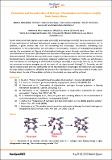Por favor, use este identificador para citar o enlazar a este item:
http://hdl.handle.net/10261/285901COMPARTIR / EXPORTAR:
 SHARE
BASE SHARE
BASE
|
|
| Visualizar otros formatos: MARC | Dublin Core | RDF | ORE | MODS | METS | DIDL | DATACITE | |

| Campo DC | Valor | Lengua/Idioma |
|---|---|---|
| dc.contributor.author | Hernández, Marta I. | - |
| dc.contributor.author | Valentín-Rodríguez, Mónica A. | - |
| dc.contributor.author | Campos-Martínez, José | - |
| dc.contributor.author | Hernández Lamoneda, Ramón | - |
| dc.contributor.author | Bartolomei, Massimiliano | - |
| dc.date.accessioned | 2022-12-30T10:40:03Z | - |
| dc.date.available | 2022-12-30T10:40:03Z | - |
| dc.date.issued | 2022-05-17 | - |
| dc.identifier.citation | Nanoscience and Nanotechnology (2022) | - |
| dc.identifier.uri | http://hdl.handle.net/10261/285901 | - |
| dc.description | Nanoscience and Nanotechnology (N&N), Madrid, mayo 17-20, 2022 | - |
| dc.description.abstract | Recent discoveries that graphene permeates protons[1] and hydrogen atoms[2] have opened up prospects of new applications in hydrogen technologies, energy storage and conversion, isotope separation, etc. In addition, a great interest has risen for uncovering the microscopic mechanisms underlying such observations. In the presentation, we will address two processes involved in hydrogenated graphene, namely, the permeation or flipping of chemisorbed hydrogen atoms through a graphene layer and the recombination of these atoms (desorption and formation of hydrogen molecules, a reaction that can occur after permeation). With the aim to provide some insight into these processes, we have carried out density functional theory computations using large molecular prototypes of graphene. Firstly, we will discuss a new mechanism for the flipping of chemisorbed hydrogen atoms[3] or protons[4] (see Fig. 1), for which the estimated activation energies are of the order of the experimental findings[1,2]. Secondly, we will report reaction paths and rate coefficients for the recombination of hydrogen and deuterium and analyze the large isotopic substitution effects[5] observed in thermal desorption measurements[6,7]. Finally, some findings about the role of Stone-Wales defects on the studied processes will be outlined. References [1] S. Hu et al, ¿Proton transport through one-atom-thick crystals¿, Nature, 516 (2014) 227. [2] P. Z. Sun et al, ¿Limits on gas impermeability of graphene¿, Nature, 579 (2020) 229 [3] M. Bartolomei et al, ¿Permeation of chemisorbed hydrogen through graphene: a flipping mechanism elucidated¿, Carbon, 178 (2021) 718 [4] M. Bartolomei et al, ¿Graphene multi-protonation: A cooperative mechanism for proton permeation¿, Carbon, 144 (2019) 144, 724. [5] M. A. Valentín-Rodríguez et al, ¿Reaction paths and tunneling effects in the recombination of H2/D2 from graphene nanoflakes¿, in preparation (2022) [6] T. Zecho et al, ¿Adsorption of hydrogen and deuterium atoms on the (0001) graphite surface¿, J. Chem. Phys. 117, 8486 (2002) [7] L. Hornekaer et al, ¿Metastable structures and recombination pathways for atomic hydrogen on the graphite (0001) surface¿, Phys. Rev. Lett., 96 (2006) 156104 | - |
| dc.language | eng | - |
| dc.rights | openAccess | - |
| dc.title | Permeation and Recombination of Hydrogen Chemisorbed on Graphene: Insights from Computations | - |
| dc.type | comunicación de congreso | - |
| dc.date.updated | 2022-12-30T10:40:03Z | - |
| dc.relation.csic | Sí | - |
| dc.type.coar | http://purl.org/coar/resource_type/c_5794 | es_ES |
| item.grantfulltext | open | - |
| item.fulltext | With Fulltext | - |
| item.openairecristype | http://purl.org/coar/resource_type/c_18cf | - |
| item.cerifentitytype | Publications | - |
| item.openairetype | comunicación de congreso | - |
| Aparece en las colecciones: | (CFMAC-IFF) Comunicaciones congresos | |
Ficheros en este ítem:
| Fichero | Descripción | Tamaño | Formato | |
|---|---|---|---|---|
| Permeation and Recombination.pdf | 564,88 kB | Adobe PDF |  Visualizar/Abrir |
CORE Recommender
NOTA: Los ítems de Digital.CSIC están protegidos por copyright, con todos los derechos reservados, a menos que se indique lo contrario.
